The Sky Provides
Brad Lancaster ’91 is helping make rainwater harvesting accessible to all.
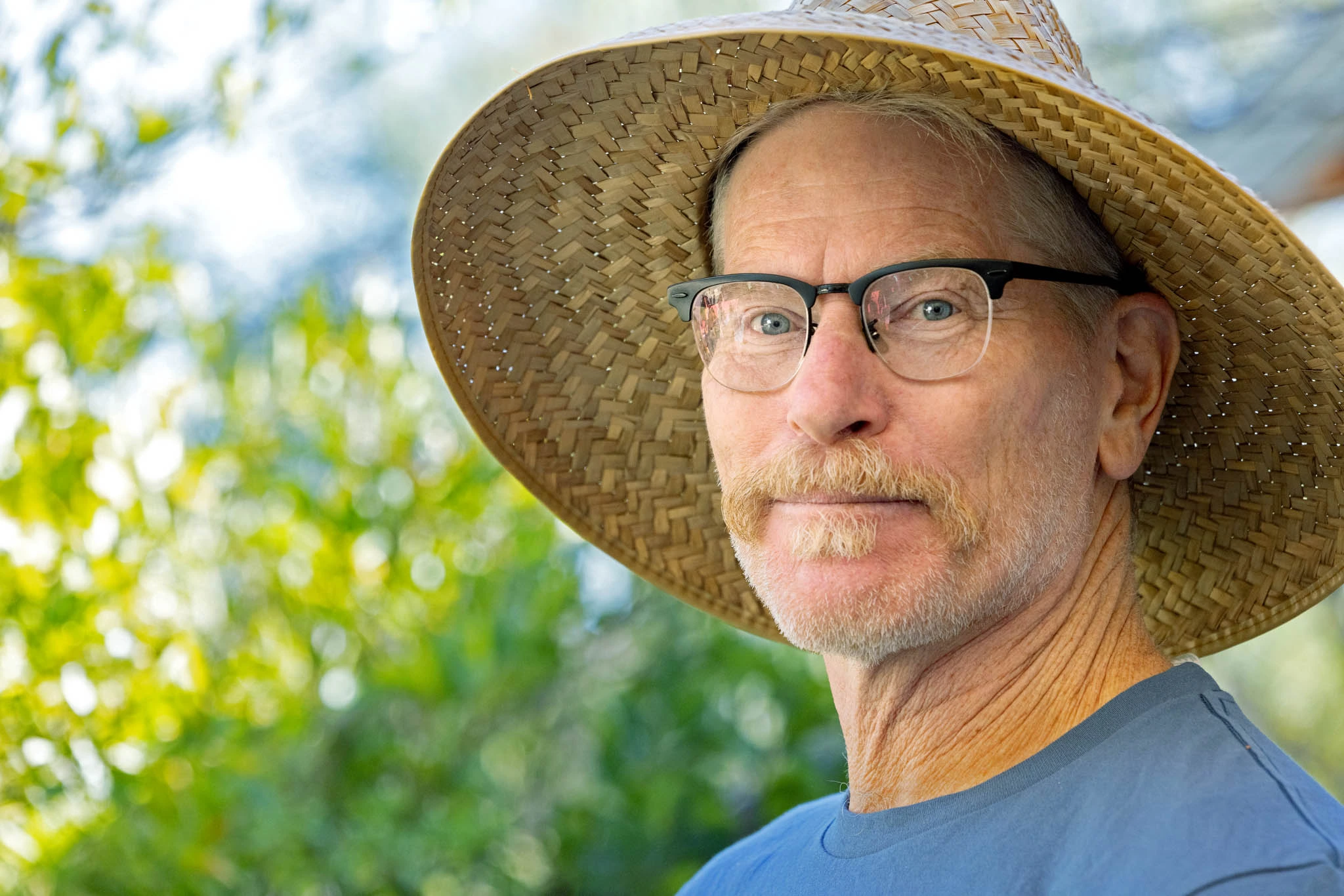
Since 1996, Lancaster has helped plant nearly 2,000 native food-bearing trees and thousands of understory plants in the Dunbar Spring neighborhood at the north end of downtown Tucson.
Chris Richards
University of Arizona graduate Brad Lancaster ’91 is a tall, striking man who you might see riding his bike or walking his Nigerian Dwarf goats down a block in Tucson’s Dunbar Spring neighborhood. He’s also the author of a two-volume book series, “Rainwater Harvesting for Drylands and Beyond,” which has become essential reading for urban desert dwellers. Volume 1 is available in Turkish and Arabic, and a Spanish-language edition will be available in 2025.
Lancaster graduated with an interdisciplinary major in anthropology, humanities and Spanish. He was busy outside the classroom, too, volunteering with the Student Union Activities Board and helping start KAMP, the student radio station. His time at the U of A cultivated a desire to see the world, and in 1995 he went on an adventure in Africa that would change his life.
In southern Zimbabwe, he met a man named Zephaniah Phiri Maseko. Maseko had designed a model farm, growing fruits and vegetables with only rainwater in a dryland similar to Tucson. “Mr. Phiri,” as Brad affectionately calls him, “made it all click for me.”
Promoting rainwater harvesting in desert climates became Brad’s life’s work. His home in central Tucson has become a showcase for how a landscape of food- and medicinal-bearing native plants can thrive using only the water that falls from the sky.
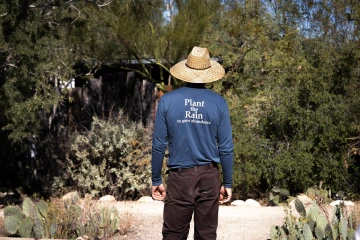
Lancaster’s efforts have led to the harvesting of over a million gallons of street runoff in streetside and in-street rain gardens annually.
Chris Richards
Brad and his brother, Rodd, moved to the Dunbar Spring neighborhood in 1994, just before Brad’s African sojourn. They bought a run-down, 740-square-foot adobe house on a 1/8-acre lot. “Such a house was all we could afford,” he says. “But it was an amazing learning experience as we figured out how to do the roof repair, electrical work, plumbing, carpentry, adobe restoration, et cetera.”
The central neighborhood was a plus. “We loved that its location on the north side of downtown would enable us to get around most places by bike or foot,” Brad says. He sold his VW truck in 1996 and hasn’t owned a car since.
One of the first things that Brad and Rodd did was to plant new trees, with the goal of harvesting enough rainwater to grow them without tapping into the municipal water supply. Tucson only gets about 11 inches of rain a year, and since 1993, the city has relied on a supplement of water from the Lower Colorado River. That supplement arrives via the Central Arizona Project and, unfortunately, it’s in jeopardy. As the Arizona Water Department reports, “The Colorado River Basin has been in a prolonged drought, exacerbated by climate change. We are experiencing the driest conditions in the basin in more than 1,200 years.”
Brad and his brother now harvest about 100,000 gallons of rainwater a year on their small lot and adjoining public right-of-way. That’s enough to meet their basic household needs, except in the driest years when they resort to the public water supply. It’s become Brad’s mission to teach others how to harvest and use rainwater, too.
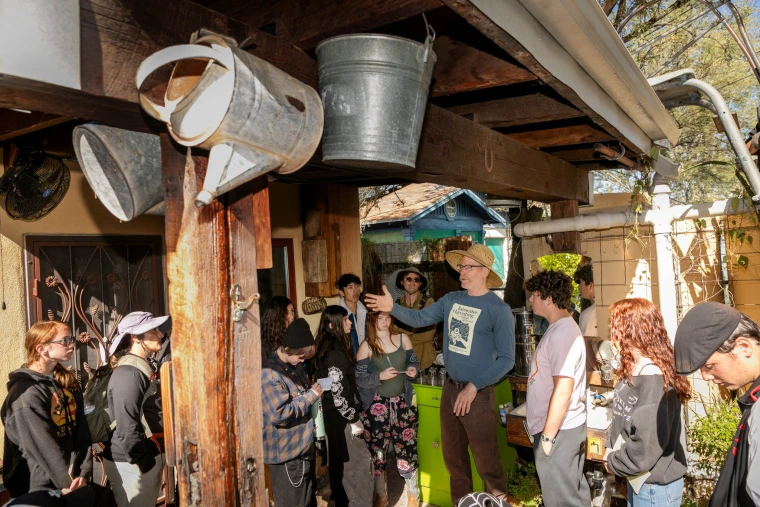
Chris Richards
On a hot and unexpectedly humid morning last fall, about 30 people joined him for a tour along Ninth Avenue just west of Stone Avenue. The folks gathered beneath the shade of mesquites and ironwoods to learn about rainwater harvesting firsthand.
Brad invited them to look all around. The first step, he tells them, is to observe your surroundings.
A dense thicket of desert shrubs grows along the curbside. The Lancasters had dug deep and wide into the ground, creating basins to capture rainwater. Their “harvest” waters the tall native trees they planted. Next, they erected earthen mounds, called berms, to channel water into the basins. And they went on to build more berms and basins in their backyard for gardens of hackberry, wolfberry and other fruit-bearing desert plants.
They also found ways to divert runoff from the street into their front yard. Brad laughingly tells the group that some of their methods were “pre-legal.”
“We started on Sunday mornings, when no one from the city was watching. That’s when we cut the curbs. The city finally realized and came to look at all the great stuff we were doing, and we started a dialogue. It took three years to legalize, but now it’s not only legal to cut into the curb but incentivized [for homeowners] with a $2,000 rebate.”
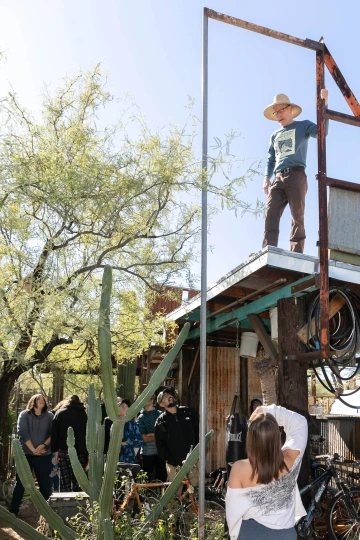
Chris Richards
From the beginning, the brothers also worked hard to meet their neighbors. Brad recalls, “We would go knocking on doors, and we went to a bunch of neighborhood meetings. And then there were community potlucks, and we got to know more of our neighbors. We just kept having conversations, asking, what do we want as a community? ... How could we have more community interaction? One of the ideas that came up was, why don’t we have a tree planting?” So Brad organized planting parties, and when they had the money, they paid local teenagers to help with the digging and the planting.
Now, more than 30 years later, Ninth Avenue and many of the surrounding streets are urban oases. The shade trees are still young, but they have filled out, and the desert shrubs underneath them grow tall and lush. In places, basins called chicanes, which look like islands of trees, have been dug in the street itself. They are carefully placed to slow down speeding cars and encourage curbside parking.
As the tour walked on, Brad showed off educational signs posted along the street. He designed some, while others were made in cooperation with the University of Arizona Campus Arboretum. Some outline the basics of rainwater harvesting, with before and after photos of streetscapes; others give the names of curbside plants — in Latin, English and Spanish, and some also in O’Odham and Yoeme.
Down the street is a community bulletin board, and up another block is a community checkerboard: a metal sculpture with a drawer full of chessmen and checkers. What better way to invite neighbors to come out and play?
The tour also explored the Lancasters’ backyard to see more of the ways they harvest rainwater. A huge cement cistern and assorted water tanks collect storm runoff from the rooftops. An elaborate gray water system stockpiles water from two outdoor showers and a washing machine. In one corner, there are pens for Brad’s chickens and the Nigerian Dwarf goats, his four-legged weed-eaters.
The Dunbar Spring tour is just one of Brad’s many efforts to plant the seeds of rainwater harvesting. Along with a busy schedule of public talks, he’s created a fun and lively website, filled with resources to inspire do-it-yourselfers: www.harvestingrainwater.com. You’ll find interviews, podcasts and even a collection of songs about water by Tucson musicians. You can order his books, there, too.
Mr. Phiri would be proud.
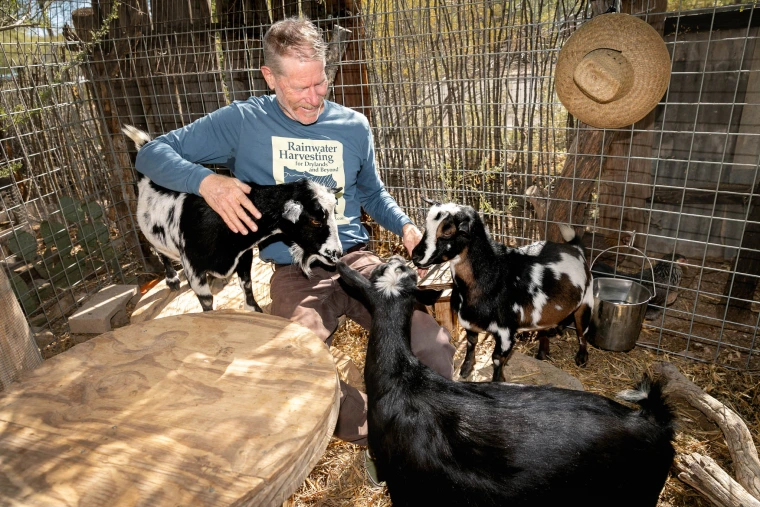
Chris Richards
